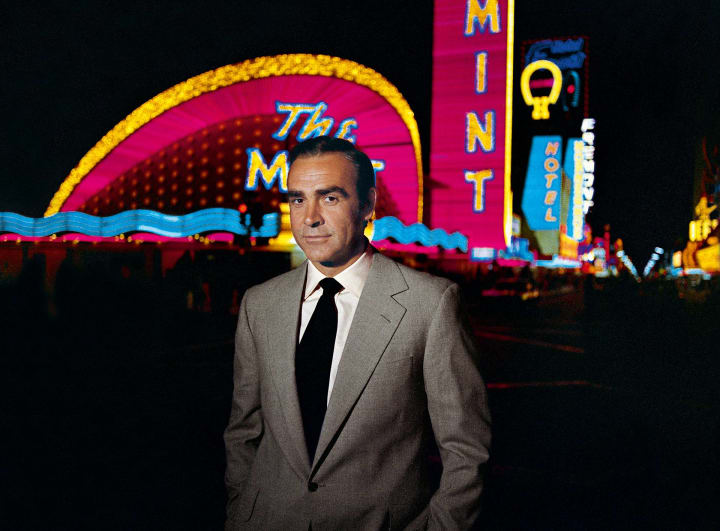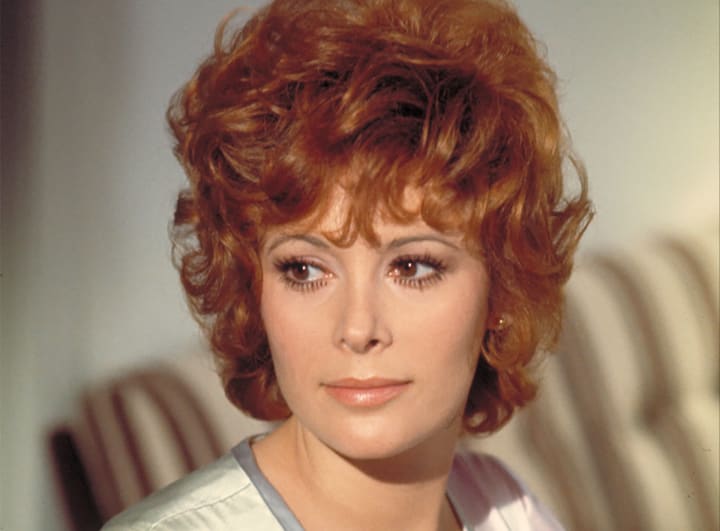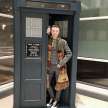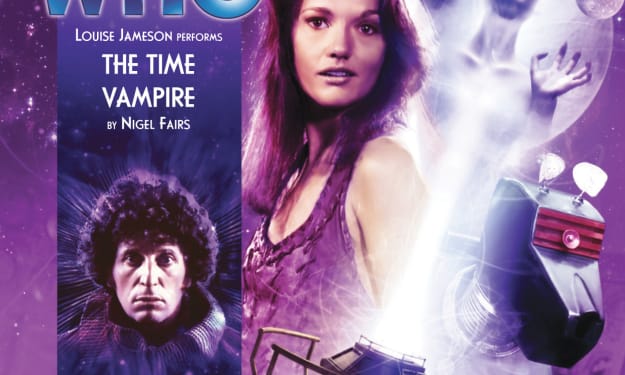#60yearsofJamesBond: Diamonds are Forever
In the first of a new series designed to celebrate 60 years of the James Bond franchise, I take a look back at Sean Connery's final outing in the role.

In 1971, James Bond was going through a bit of a crisis. After star Sean Connery decided he wanted to leave after 1967's "You Only Live Twice", producers Harry Saltzman and Albert R. Broccoli cast George Lazenby for 1969's "On Her Majesty's Secret Service". However, due to a combination of poor relations and Lazenby's agent believing the franchise to be over, he didn't sign on for another film. This left Saltzman and Broccoli in a bit of a bind: either recast the role, which could present similar problems to those encountered previously, or try to entice Connery back. In the end, studio United Artists decided for them: get Connery back, and money was no object. Connery ended up returning for $1.25 million, a then unheard of sum, and a huge amount of creative control over this film and two back-to-back films of his choice. After a rocky few years, the producers decided they wanted to go back to the formula of "Goldfinger", the movie that had really launched Bond onto the global stage: big action set pieces, extravagant villains, direction from Guy Hamilton and a theme song sung by Shirley Bassey. And, while being a commercial and box office smash back in 1971, it is a film that isn't looked back upon as one of the greats, with an outrageous plot and a lacklustre central performance from Connery. In contrast to "On Her Majesty's Secret Service", which has gone up in appreciation since its release, this is a film that time has not been kind to, and doesn't stand out as one of the greats - even for comedy camp value, which this film provides in spades.

Starting out with Bond hunting down Blofeld (in a pre-titles sequence that feels like it could have been picking up from the ending of "On Her Majesty's Secret Service", were it not for the completely comedic tone), this film maintains a comedic air throughout, and is at vast contrast with not just OHMSS, but every other Bond film up to this point. Even "Goldfinger", with its huge set pieces and strong sense of humour and punchline, was never trying as hard to be funny as this film. It all feels like one extended gag - except the gag is never paid off. It isn't trying to be subversive, or lull the audience into a false sense of security: it's playing out more like a parody of a Bond film, rather than an actual Bond film, and, as such, something just doesn't feel right throughout. Unlike a lot of Bond films that don't work, it isn't that the tone is all over the place: this does have a consistent tone throughout. It's just that the tone is cheesy, and there are points where this movie gives Austin Powers a run for its money. I don't think Bond works particularly well when it decides to parody itself: it ends up going so far over the top that it stops being fun, and just starts being derivative and dull. As I mentioned at the top of this feature, this movie is trying to harken back to "Goldfinger": probably the Bond film with the longest reach in the public conscience. But "Goldfinger" kept its feet on the ground, it remembered to include moments of jeopardy, and it maintained the darker tone of earlier Bond flicks "Dr. No" and "From Russia With Love". Compare and contrast the laser beam scene from "Goldfinger" with the coffin sequence from this film: thematically, both similar. But, whereas the laser beam sequence has two great central performances, tight editing and a wonderful John Barry score, the coffin sequence feels more like the audience should be laughing along, rather than feeling the peril for our hero. Instead of Barry's score, we get cheep and cheesy funeral organ music, which just kill any tension the scene was going for. Bond films can have fun gags and extreme set pieces, but there should always be tension and danger too. The best Bond films marry the two together: "Diamonds are Forever" just goes hard on the gags, and, as such, the whole thing becomes very tiresome very quickly.

While you might expect a film like this to have a very lightweight plot, "Diamonds are Forever" actually has a hugely complicated plot that, if you want to know what is going on, you better pay close attention to. For a large part of the film, there's at least three major plot strands (the diamond smuggling, the mystery of Wilard Whyte and the exploits of Kidd and Wint), and it isn't until the final third of the film that these strands even start to be tied together. The film jumps from set piece to set piece, with no real idea of how to connect them together, and what connecting tissue there is is flimsy and lightweight at best. I understand that the basic plot of this film came to Cubby Broccoli in a dream - and this clearly shows, because this feels like the product of a cheese-induced nightmare. It feels like the writers, director, producers and star were just making it up as they went along, and including loads of different things that they thought people wanted to see. In that sense, I can see why this movie was commercially more successful than "On Her Majesty's Secret Service" or even "You Only Live Twice": because it does feature a number of moments that, to the general cinema-going audience, are what they would expect from a Bond film. But OHMSS, like it or not, did shake up the formula, and provide some interesting new avenues for storytelling. "Diamonds are Forever" goes back to formulaic storytelling of the kind only really seen previously in "Thunderball" (though would become the stock in trade of some of the Bond movies of the 70s and 80s), and doesn't dare to go beyond 'disposable action flick'. Back in 1971, I can see why that might be enjoyable, but now, in the era where we can watch any James Bond film at our fingertips, one wonders what the point was, if they weren't going to say anything new about the franchise.

And, like the plot, I'm afraid this by-the-numbers approach also extends to the characters. None of them show any interesting elements beyond the re-use of standard Bond tropes, and honestly, there are far too many of them to keep track. Tiffany Case is, without doubt, the most unlikely diamond smuggler of all time (maybe that's the point, but still), and her presence doesn't really enhance the film in the usual ways a Bond girl does. She's as dry as cardboard, and her and Bond have no real spark: she's a far cry from Tracey Bond or Pussy Galore or even Domino Duval. While Jill St. John does the best she can, she's got her work cut out for her with a thankless role. As for Blofeld... well, he is little more than a shadow of his former self. Charles Grey does the best he can with the part (he's a incredibly accomplished actor, after all), but this version of Blofeld has little of the sinister power of any of the character's previous appearances. The double Blofeldv gag gets old pretty quickly, and even his cross-dressing tendencies do little to produce anything more than a wry smile. The rest of the cast do contain a number of noted actors, both British and American, but the parts are so thankless, there's not really enough for them to get their teeth into. Wilard Whyte is Howard Hughes just with the name changed, and how we are meant to believe someone so easily gulled by Blofeld got to be head of a huge business empire, I will never know. Plenty O'Toole is nice enough - but she's only in the film for basically three scenes, and that's it, and our regulars (Q, M, Moneypenny) all suffer the same fate as well. The only two characters who are actually quite interesting are Mr Wint and Mr Kidd, brilliantly played by Bruce Glover and Putter Smith respectively, who bring an insidious air to proceedings in their opening scenes especially, as they kill each link in the diamond chain. I know a lot of people think they're silly, and they are, in a way, but the film does take care to treat them as a genuine threat, not just a punchline.

And then we come to James Bond himself. Now, of course we all understand how Sean Connery was brought back: I outlined it at the top of this article. However, what I think we do need to dive into is why Connery was brought back. After all, they had been quite happy to recast the role of Bond in the previous film, "On Her Majesty's Secret Service", so why was there such a desperation to get Connery back? Put simply, it was believed that James Bond couldn't survive without Connery. He was the face of the franchise, and it was believed that, without his presence in the title role, there would be no James Bond. It's understandable - after all, it was his talent in the earliest films in the series that had made him an international superstar, and propelled the Bond series to the height of kudos that it enjoys today. However, after the slightly disappointing box office results of OHMSS, coupled with George Lazenby departing the series soon after production concluded, it reinforced the view that only Connery could play the lead role. So, Connery got a huge massive pay check (which he did at least use to set up the Scottish International Education Trust to his credit), and the chance to lead up two films of his choice (of which only one got made), and the studio was happy. Sadly, however, this is probably the most phoned-in performance of any actor as Bond, and it ends up looking more like Connery was only in it for the money. It doesn't help that this film feels like it is just going through the motions, but a more engaged performance would probably have helped this film feel less like a time killer. He looks thoroughly bored throughout, and his famous 'Bond, James Bond' line at the top of the film lacks any sort of punch. I don't doubt that Connery isn't a good actor, and his performances in every other Bond film are exemplary. But this is a world away from the swarve action hero of the earliest Bond films, and it just adds to the feeling that this whole film was merely made to make money, not for any kind of artistic reason. It's disappointing, that's all that can be said about it.

Finally, on a production front, this is 'mostly' pretty good. As mentioned above, Guy Hamilton returns to direct, having previously helmed "Goldfinger", and brings all the attributes that made that film great to bear here. It's isn't as successful as his prior contribution, but you can tell he's trying to make the material work, and some scenes are actually quite successful. The fight in the lift in Amsterdam is a shining example of this commitment: unlike a lot of the film, this is gritty, realistic, and works at showing the edge that makes Bond films work. He knows how to direct the action pieces, and, even if he finds it hard to bring life into the slightly drier sections of the movie, he gives it a good attempt. Some of the effects work hasn't held up as well, I'm afraid to say. The practical effects look fantastic (a lot of the battle on the oil rig at the end looks spectacular), but it's the video effects that leave a lot to be desired. The sequences of the space laser blowing up various targets are, I'm afraid, laughably bad, and make it look more like an Austin Powers parody than an actual scene in an actual James Bond film. Ken Adam's production design once again excels, although unlike his chasmic sets for Blofeld's base in "You Only Live Twice" or Dr. No's control centre in "Dr. No", there's not one that really 'stands out' as it were, other than maybe Wilard Whyte's penthouse (which has got 'Bond villain' written all over it). Finally, John Barry's score is bombastic and exciting, although this soundtrack is very orchestral, in sharp contrast to the electronic and proto-synth scores of "On Her Majesty's Secret Service" or even "You Only Live Twice". But it does the job well, and, when coupled with Shirley Bassey's wonderful title song, it makes for at least one element of this movie I can say was good, without having to add the word 'but' afterwards.

Overall, despite some positives, "Diamonds are Forever" remains one of the weakest Bond films in the franchise's 60 year history. A by-the-numbers plot, a lack of genuine stakes and tension and a phoned in performance from the leading man all contribute to the film's major failings, and give the impression of a series at a creative crossroads. In many ways, this was a sign of things to come for the next five years and the next two films; although, with the next Bond film, Sean Connery would permanently depart from the role... to be replaced by a new actor, one who would chalk up the most appearances in the role to date. But, for now, it's a shame Connery had to bow out like this. "Diamonds are Forever" is a poor final showing for the man who, without him, we wouldn't be sat here today talking about these films. It's no "Goldfinger", and, coming off the back of something like "On Her Majesty's Secret Service", it is definitely a disappointment.
You can purchase "Diamonds are Forever" on Blu-Ray from Amazon by clicking the link below, or from all good Blu-Ray and DVD shops.

All pictures copyright to EON Productions. Thank you very much for reading.
JAMES BOND WILL RETURN...
About the Creator
Joseph A. Morrison
26. Fan of Doctor Who, Blake's 7, The Prisoner and more old-fashioned TV. Reviewer, wannabe writer and general twit.
Reader insights
Outstanding
Excellent work. Looking forward to reading more!
Top insights
Excellent storytelling
Original narrative & well developed characters
Eye opening
Niche topic & fresh perspectives







Comments (3)
I love James Bond. Thanks for all this info!!!
A lot of information here that I never knew. Many thanks...!
Interesting thoughts on classic film. Thank you for sharing. :)